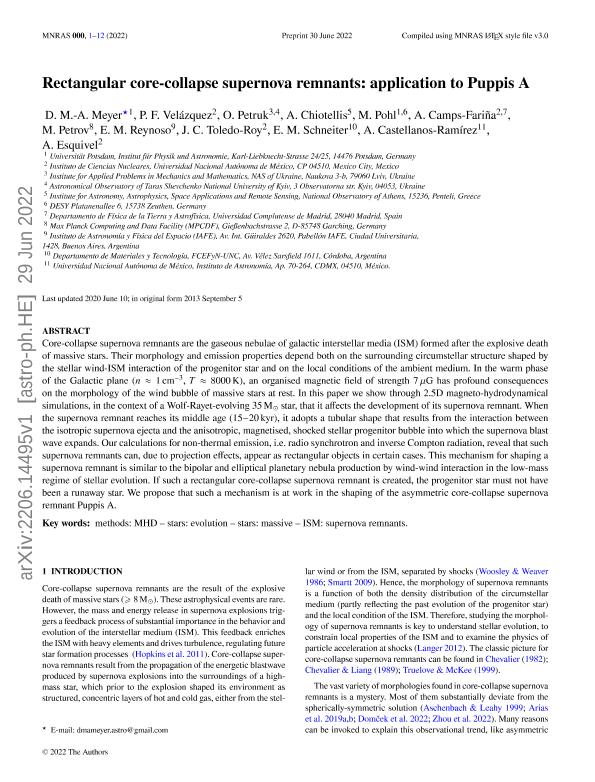Mostrar el registro sencillo del ítem
dc.contributor.author
Meyer, D. M. A.
dc.contributor.author
Velázquez, Pablo F.
dc.contributor.author
Petruk, Oleg
dc.contributor.author
Chiotellis, Alexandros
dc.contributor.author
Pohl, Michael
dc.contributor.author
Camps Fariña, A.
dc.contributor.author
Petrov, M.
dc.contributor.author
Reynoso, Estela Marta

dc.contributor.author
Toledo Roy, J. C.
dc.contributor.author
Schneiter, Ernesto Matías

dc.contributor.author
Castellanos Ramírez, A.
dc.contributor.author
Esquivel, Alejandro
dc.date.available
2023-11-01T13:04:58Z
dc.date.issued
2022-09
dc.identifier.citation
Meyer, D. M. A.; Velázquez, Pablo F.; Petruk, Oleg; Chiotellis, Alexandros; Pohl, Michael; et al.; Rectangular core-collapse supernova remnants: Application to Puppis A; Wiley Blackwell Publishing, Inc; Monthly Notices of the Royal Astronomical Society; 515; 1; 9-2022; 594-605
dc.identifier.issn
0035-8711
dc.identifier.uri
http://hdl.handle.net/11336/216753
dc.description.abstract
Core-collapse supernova remnants are the gaseous nebulae of galactic interstellar media (ISM) formed after the explosive death of massive stars. Their morphology and emission properties depend both on the surrounding circumstellar structure shaped by the stellar wind-ISM interaction of the progenitor star and on the local conditions of the ambient medium. In the warm phase of the Galactic plane (n ≈ 1 cm-3, T ≈ 8000 K), an organized magnetic field of strength 7μ G has profound consequences on the morphology of the wind bubble of massive stars at rest. In this paper, we show through 2.5D magnetohydrodynamical simulations, in the context of a Wolf-Rayet-evolving 35 M⊙ that it affects the development of its supernova remnant. When the supernova remnant reaches its middle age (15-20 kyr), it adopts a tubular shape that results from the interaction between the isotropic supernova ejecta and the anisotropic, magnetized, shocked stellar progenitor bubble into which the supernova blast wave expands. Our calculations for non-thermal emission, i.e. radio synchrotron and inverse-Compton radiation, reveal that such supernova remnants can, due to projection effects, appear as rectangular objects in certain cases. This mechanism for shaping a supernova remnant is similar to the bipolar and elliptical planetary nebula production by wind-wind interaction in the low-mass regime of stellar evolution. If such a rectangular core-collapse supernova remnant is created, the progenitor star must not have been a runaway star. We propose that such a mechanism is at work in the shaping of the asymmetric core-collapse supernova remnant Puppis A.
dc.format
application/pdf
dc.language.iso
eng
dc.publisher
Wiley Blackwell Publishing, Inc

dc.rights
info:eu-repo/semantics/openAccess
dc.rights.uri
https://creativecommons.org/licenses/by-nc-sa/2.5/ar/
dc.subject
ISM: SUPERNOVA REMNANTS
dc.subject
METHODS: MHD
dc.subject
STARS: EVOLUTION
dc.subject
STARS: MASSIVE
dc.subject.classification
Astronomía

dc.subject.classification
Ciencias Físicas

dc.subject.classification
CIENCIAS NATURALES Y EXACTAS

dc.title
Rectangular core-collapse supernova remnants: Application to Puppis A
dc.type
info:eu-repo/semantics/article
dc.type
info:ar-repo/semantics/artículo
dc.type
info:eu-repo/semantics/publishedVersion
dc.date.updated
2023-11-01T12:04:34Z
dc.journal.volume
515
dc.journal.number
1
dc.journal.pagination
594-605
dc.journal.pais
Reino Unido

dc.journal.ciudad
Londres
dc.description.fil
Fil: Meyer, D. M. A.. Universitat Potsdam; Alemania
dc.description.fil
Fil: Velázquez, Pablo F.. Universidad Nacional Autónoma de México. Instituto de Ciencias Nucleares; México
dc.description.fil
Fil: Petruk, Oleg. No especifíca;
dc.description.fil
Fil: Chiotellis, Alexandros. National Observatory Of Athens; Grecia
dc.description.fil
Fil: Pohl, Michael. Universitat Potsdam; Alemania
dc.description.fil
Fil: Camps Fariña, A.. Universidad Nacional Autónoma de México. Instituto de Ciencias Nucleares; México. Universidad Complutense de Madrid; España
dc.description.fil
Fil: Petrov, M.. Max Planck Computing And Data Facility; Alemania
dc.description.fil
Fil: Reynoso, Estela Marta. Consejo Nacional de Investigaciones Científicas y Técnicas. Oficina de Coordinación Administrativa Ciudad Universitaria. Instituto de Astronomía y Física del Espacio. - Universidad de Buenos Aires. Facultad de Ciencias Exactas y Naturales. Instituto de Astronomía y Física del Espacio; Argentina
dc.description.fil
Fil: Toledo Roy, J. C.. Universidad Nacional Autónoma de México. Instituto de Ciencias Nucleares; México
dc.description.fil
Fil: Schneiter, Ernesto Matías. Universidad Nacional de Córdoba. Facultad de Cs.exactas Físicas y Naturales. Departamento de Materiales y Tecnología; Argentina
dc.description.fil
Fil: Castellanos Ramírez, A.. Universidad Nacional Autonoma de Mexico. Instituto de Astronomia; México
dc.description.fil
Fil: Esquivel, Alejandro. Universidad Nacional Autónoma de México. Instituto de Ciencias Nucleares; México
dc.journal.title
Monthly Notices of the Royal Astronomical Society

dc.relation.alternativeid
info:eu-repo/semantics/altIdentifier/url/https://academic.oup.com/mnras/article-abstract/515/1/594/6628661?redirectedFrom=fulltext
dc.relation.alternativeid
info:eu-repo/semantics/altIdentifier/doi/http://dx.doi.org/10.1093/mnras/stac1832
Archivos asociados
